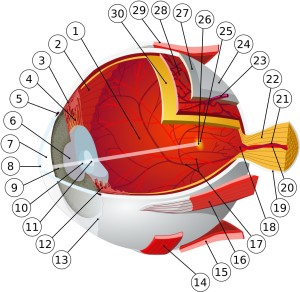What is Dry Eye?

1: posterior chamber 2: ora serrata 3: ciliary muscle 4: ciliary zonules 5: canal of Schlemm 6: pupil 7: anterior chamber 8: cornea 9: iris 10: lens cortex 11: lens nucleus 12: ciliary process 13: conjuntiva 14: inferior oblique muscule 15: inferior rectus muscule 16: medial rectus muscle 17: retinal arteries and veins 18: optic disc 19: dura mater 20: central retinal artery 21: central retinal vein 22: optical nerve 23: vorticose vein 24: bulbar sheat 25: macula 26: fovea 27: sclera 28: choroid 29: superior rectus muscule 30: retina.
Dry Eye is a long-term chronic disease that causes discomfort and may compromise vision if left untreated. There are two forms of Dry Eye: Evaporative Dry Eye and Aqueous Dry Eye. The condition occurs when the eyes do not produce enough tears or the appropriate quality of tears to keep the eyes lubricated, healthy and comfortable. The eyes produce tears either at a slow, steady pace or they produce large quantities of tears due to irritation or crying. Excessive tearing from Dry Eye may sound counter intuitive. but it is the eye’s response to discomfort. If the tears do not keep the eye wet enough, the eye becomes irritated and prompts the gland to make more tears.
Blinking produces a film of tears that covers the eye, making its surface smooth and clear. Good vision is not possible without this tear film. The tear film consists of three layers:
Lipid (oil) layer – lubricates and prevents evaporation
Aqueous (water) layer – nourishes and protects the cornea
Mucin Layer – adheres to the eye
Aqueous Deficient Dry Eye occurs when the lacrimal glands do not create a sufficient amount of aqueous (water) to keep the eyes moist. Traditional treatments such as topical eye drops may help alleviate symptoms from this form of dry eye.
Evaporative Dry Eye is caused by blockage in the Meibomian glands that create the lipid (oil) layer of the tear film and are located in the eyelids. This condition of obstructed glands is know as Meibomian Gland Dysfunction (MGD). When the glands aren’t working properly, they do not produce enough tear film oil and the tears, which lubricate and keep the eyes comfortable, evaporate too quickly.
What Causes Evaporative Dry Eye?
Age, contact lens use and hygiene, cosmetic use, and illnesses, particularly diabetes, may cause or exacerbate Evaporative Dry Eye.
Hormonal changes in women during menopause, particularly decreasing levels of estrogen, can cause thickening of the oils secreted by the Meibomian glands, which in turn can result in blockages.
Decreased estrogen levels may enhance conditions under which staphylococcal bacteria can proliferate in Meibomian glands. This results in a decreased oil secretion rate.
Who’s Affected?
Over 100 million people worldwide suffer form Dry Eye disease. Men and women at any age can be affected, however, Dry eye increases with age and often affects women after menopause.
What are the symptoms?
Dryness
Itching
Burning
Stinging
Tearing
Redness
Sensation of something in your eye
Sensitivity to light
If left untreated, Dry Eye can result in visual deterioration.